Papers by William M Guzman Ph.D
Esta investigación se lleva a cabo como un proceso de descubrimiento, para establecer sin lugar a... more Esta investigación se lleva a cabo como un proceso de descubrimiento, para establecer sin lugar a duda, las relaciones, número, etnia y origines de los Guzmán de Mendoza y sus numerosos descendientes, muchos de los cuales se establecieron en Chile después de su independencia de España.
Esta investigación se lleva a cabo como un proceso de descubrimiento, para establecer sin lugar a... more Esta investigación se lleva a cabo como un proceso de descubrimiento, para establecer sin lugar a duda, las relaciones, número, etnia y origines de los Guzmán de Mendoza y sus numerosos descendientes, muchos de los cuales se establecieron en Chile después de su independencia de España.
Esta investigación se lleva a cabo como un proceso de descubrimiento, para establecer sin lugar a... more Esta investigación se lleva a cabo como un proceso de descubrimiento, para establecer sin lugar a duda, las relaciones, número, etnia y origines de los Guzmán de Mendoza y sus numerosos descendientes, muchos de los cuales se establecieron en Chile después de su independencia de España.
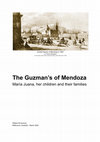
This investigation is carried out as a process of discovery, to establish beyond doubt the relati... more This investigation is carried out as a process of discovery, to establish beyond doubt the relationships, number, ethnicity and origins of the Guzmán de Mendoza and their numerous descendants, many of whom settled in Chile after its independence from Spain.
The investigation tries to discover and document information about María Juana, a slave of the Convent of Santo Domingo de Mendoza. María Juana was the matriarch of all the Guzmán family referred to in this investigation. María Juana's ethnic origin was unknown and until recently assumed African; now there is information that has been obtained thanks to the advances of science, which indicates the origin of María Juana as Nigerian and / or Algerian.
The investigation documents information about María Juana and her children, all of them also slaves of the Dominican Convent, as a result of being born the children of a slave. Also included are the families of María Juana's children and grandchildren, many of whom were also born into slavery.
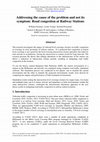
ATRF 2018 Conference - Darwin, Australia, 2018
The research investigates the impact of railroad level crossings closures on traffic congestion a... more The research investigates the impact of railroad level crossings closures on traffic congestion at crossings in close proximity of railway stations. It is proposed that congestion at station level crossings is not caused by the level crossing intersection closure operation, but rather by train arrivals or at platforms, forcing the intersection to remain closed for long intervals. The research presents the theory that making alterations to the infrastructure of the station can derive a reduction of intersection closure periods, resulting in mitigating road traffic congestion at the location. To test the theory, named Departure Side Platforms (DSP), the station environment of a station on the Melbourne rail network was simulated using computer road traffic simulation software. The simulation process was conducted in two phases: one to emulate the current environment and the other to emulate the proposed environment; results were derived by comparing the outputs and performance of both simulated environments. Simulation results testing the intersection level crossings closures by single trains, two-trains and multiple-trains (up to 6 trains) arrivals and departures at both environments (within the same intersection closure), confirmed the infrastructure alterations approach of the new theory results in mitigating road traffic congestion at railway station locations.
This thesis investigates the impact of level crossings closures on traffic congestion at level cr... more This thesis investigates the impact of level crossings closures on traffic congestion at level crossings adjacent to or in the close proximity of railway stations, proposing that making alterations to the infrastructure of the station can derive a reducti

Computers in Railways XIV, 2014
In August 2013 and for the third consecutive year, Melbourne has been accredited as the most live... more In August 2013 and for the third consecutive year, Melbourne has been accredited as the most liveable city in the world. However, the city is also known and credited for a less attractive reason as "The City of Level Crossings"; the city's metropolitan area is home to 170 railroad level crossings (RLX). Since 2006, Melbourne has experienced unprecedented train patronage demand. Victorian transport authorities, facing capacity, demand and overcrowding problems, have acquired new train sets, established new timetables that introduced additional urban train services, and prepared long term plans to address the issue. However, the additional train services result in a 'catch 22' situation. The additional train traffic causes extra boom gate activity at railroad level crossings, which in turns leads to additional vehicles congestion on Melbourne's roads. This research investigates and proposes the introduction of Zonal Operations (ZO) in the Caulfield Group corridor that includes some of Melbourne's longest and busiest lines within the rail network. The research discusses the concept of ZO, analyses the claim that ZO resolves capacity and overcrowding problems, a claim proposed in research literature. In addition, this research confirms that ZO has the potential to reduce the number of times boom gates are lowered at RLXs, and to mitigate road traffic congestion at RLXs. By doing this, a better understanding is gained in how ZO in railways can be used to mitigate road traffic congestion issues at RLX locations.
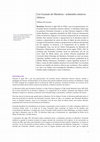
The Journal of Genealogy and Family History, Vol. 6, No. 1, 2022
During the 19th century in Chile and for three generations, the Guzmán’s were acclaimed classical... more During the 19th century in Chile and for three generations, the Guzmán’s were acclaimed classical musicians. The literature indicates that their patriarch Fernando Guzmán and his son Francisco arrived in Chile from Mendoza, Argentina in about 1822. There is little or no information regarding their heritage, origins and the correct composition of their large family. There are many errors and assumptions in the literature as to the number and paternity of several of them; it is intended to correct the
misinformation and provide documentary evidence of the family origins, heritage and composition. The research makes use of the Mendoza Baptisms, Marriages and Deaths Parish Books from the 18th and 19th centuries, legal documents, and published material. It is confirmed that Fernando Guzmán was born into slavery, one of five children of Maria Juana, an African slave owned by the Santo Domingo Convent of Mendoza. Fernando married Juana Agustina, also a slave of African descent, owned by the Molina Sotomayor family. Fernando and Juana Agustina had 13 children, several of whom were also born into slavery. The Guzmán’s were a family of classical musicians par excellence. To celebrate their life and work, this research identifies and reports how the family was composed and how it evolved.

The Guzmán’s of Mendoza - acclaimed classical musicians
The Journal of Genealogy and Family History, Vol. 6, No. 1, 2022, 2022
During the 19th century in Chile and for three generations, the Guzmán’s were acclaimed classical... more During the 19th century in Chile and for three generations, the Guzmán’s were acclaimed classical musicians. The literature indicates that their patriarch Fernando Guzmán and his son Francisco arrived in Chile from Mendoza, Argentina in about 1822. There is little or no information regarding their heritage, origins and the correct composition of their large family. There are many errors and assumptions in the literature as to the number and paternity of several of them; it is intended to correct the misinformation and provide documentary evidence of the family origins, heritage and composition. The research makes use of the Mendoza Baptisms, Marriages and Deaths Parish Books from the 18th and 19th centuries, legal documents, and published material. It is confirmed that Fernando Guzmán was born into slavery, one of five children of Maria Juana, an African slave owned by the Santo Domingo Convent of Mendoza. Fernando married Juana Agustina, also a slave of African descent, owned by th...
his research investigates traffic congestion at railway level crossings adjacent to or in the clo... more his research investigates traffic congestion at railway level crossings adjacent to or in the close proximity of railway stations. Traffic congestion at railway level crossings has many implications on logistics and can significantly delay urban deliveries. We propose that a reduction of boom barriers down time periods at these locations can be derived by making alterations to the infrastructure of the railway station.
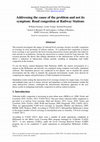
ATRF 2018 Conference - Darwin, Australia, 2018
The research investigates the impact of railroad level crossings closures on traffic congestion a... more The research investigates the impact of railroad level crossings closures on traffic congestion at crossings in close proximity of railway stations. It is proposed that congestion at station level crossings is not caused by the level crossing intersection closure operation, but rather by train arrivals or at platforms, forcing the intersection to remain closed for long intervals. The research presents the theory that making alterations to the infrastructure of the station can derive a reduction of intersection closure periods, resulting in mitigating road traffic congestion at the location. To test the theory, named Departure Side Platforms (DSP), the station environment of a station on the Melbourne rail network was simulated using computer road traffic simulation software. The simulation process was conducted in two phases: one to emulate the current environment and the other to emulate the proposed environment; results were derived by comparing the outputs and performance of both simulated environments. Simulation results testing the intersection level crossings closures by single trains, two-trains and multiple-trains (up to 6 trains) arrivals and departures at both environments (within the same intersection closure), confirmed the infrastructure alterations approach of the new theory results in mitigating road traffic congestion at railway station locations.
Departure Side Platforms: a road congestion mitigation measure
This study investigates the impact of level crossings closures on traffic congestion at crossings... more This study investigates the impact of level crossings closures on traffic congestion at crossings adjacent to or in the close proximity of railway stations, proposing the theory that making alterations to the infrastructure of the station can derive a reduction of intersection closure periods at these locations. These infrastructure alterations relate to the platform arrangements at stations, presenting an opportunity to mitigate road closure periods at level crossing intersections, thus alleviating road traffic congestion.
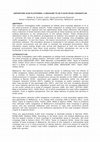
This research investigates traffic congestion at railway level crossings adjacent to or in the cl... more This research investigates traffic congestion at railway level crossings adjacent to or in the close proximity of railway stations. Traffic congestion at railway level crossings has many implications on logistics and can significantly delay urban deliveries. We propose that a reduction of boom barriers down time periods at these locations can be derived by making alterations to the infrastructure of the railway station. These infrastructure alterations relate to the platform arrangements at stations, and present an opportunity to minimise the time of roads closure periods at level crossing, thus mitigating road traffic congestion. To test this theory, the station environment is simulated using traffic simulation software. The simulation process is conducted in two phases, one to emulate the current environment and the other to emulate the proposed environment. Early simulation results testing single train arrival and departure at both the current and proposed environment have been most positive. Further simulations are yet to be conducted to test the operation of multiple train arrivals and departures.
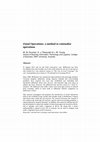
In August 2013 and for the third consecutive year, Melbourne has been accredited as the most live... more In August 2013 and for the third consecutive year, Melbourne has been accredited as the most liveable city in the world. However, the city is also known and credited for a less attractive reason as " The City of Level Crossings " ; the city's metropolitan area is home to 170 railroad level crossings (RLX). Since 2006, Melbourne has experienced unprecedented train patronage demand. Victorian transport authorities, facing capacity, demand and overcrowding problems, have acquired new train sets, established new timetables that introduced additional urban train services, and prepared long term plans to address the issue. However, the additional train services result in a 'catch 22' situation. The additional train traffic causes extra boom gate activity at railroad level crossings, which in turns leads to additional vehicles congestion on Melbourne's roads. This research investigates and proposes the introduction of Zonal Operations (ZO) in the Caulfield Group corridor that includes some of Melbourne's longest and busiest lines within the rail network. The research discusses the concept of ZO, analyses the claim that ZO resolves capacity and overcrowding problems, a claim proposed in research literature. In addition, this research confirms that ZO has the potential to reduce the number of times boom gates are lowered at RLXs, and to mitigate road traffic congestion at RLXs. By doing this, a better understanding is gained in how ZO in railways can be used to mitigate road traffic congestion issues at RLX locations.
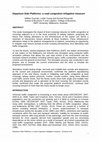
This study investigates the impact of level crossings closures on traffic congestion at crossings... more This study investigates the impact of level crossings closures on traffic congestion at crossings adjacent to or in the close proximity of railway stations, proposing the theory that making alterations to the infrastructure of the station can derive a reduction of intersection closure periods at these locations. These infrastructure alterations relate to the platform arrangements at stations, presenting an opportunity to mitigate road closure periods at level crossing intersections, thus alleviating road traffic congestion. To test the theory, named Departure Side Platforms (DSP), the station environment of one station on the Melbourne rail network was simulated using computer traffic simulation software that allows the user total control of the environment and the transport network emulated, including vehicles types, traffic composition, intersection controls and the general environment. The simulation process was conducted in two phases, one to emulate the current environment and the other to emulate the proposed environment. Simulation results testing single, two-train and multiple-train arrivals and departures at the current and proposed environment, confirmed the platform repositioning approach of the new theory, results in mitigating road traffic congestion at level crossings railway station precincts. Further, results confirm, using three different road traffic volume levels, that the theory works when both single and multiple train arrivals and departures are in operation at the level crossing; the simulation results further confirmed that under the proposed platform environment, continual level crossing closures of more than two trains would no longer occur.
Patents by William M Guzman Ph.D
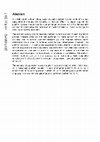
A prefabricated modular railway station reusable platform system made off-site and transported in... more A prefabricated modular railway station reusable platform system made off-site and transported in modules for assembly at location. When no longer required, the platform system modules can be dismantled and removed with ease; the modules can then be transported for installation at another location or moved to storage for later use at another installation. The modular railway station reusable platform system modules consist of platform precast concrete slabs that are sustained by beam support structures, mounted over foundation concrete sleepers. The required platform length determines the number of modules used for the infrastructure construct. The platform modules are assembled to follow straight or curved rail track centreline geometry and are adjustable; adjustable both horizontally and vertically to compensate for changes on platform requirements to reduce or minimise the platform/train edge gap. To compensate for changing circumstances, the platform system modules can be further adjusted as a maintenance task, long after completion of the installation of the modular railway station reusable platform system construct. The modular railway station reusable platform system is designed to be implemented as a temporary platform solution, a new permanent platform structure, as a replacement of an existing station platform structure exhibiting large platform/train edge gap, or to extend the length of an existing station platform structure.
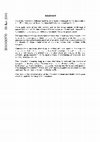
Since the inception of railways systems as a mode of transport during the middle of the 19th cent... more Since the inception of railways systems as a mode of transport during the middle of the 19th century, train stations have been built with similar configurations. Since early parts of the 20th century and as the motor vehicle proliferated, it necessitated the introduction of new safety measures at rail and road intersections, to separate the two transport modals competing for the same ground space. The new safety measures introduced to maintain the right-of-way of trains were in the form of the boom gates or boom barriers. The boom gates allow the train's free passage by closing the intersection to all other traffic. Traffic has grown overtime and the closure of mayor arterial roads at any time creates motor vehicles traffic congestion. Currently there are three alternatives in dealing with level crossing problems and these are motivated to reduce accidents at level crossings that result in death and injury of commuters and pedestrians. The alternatives are: closure of the level crossing, grade separation of the level crossing or installation of adequate level crossing warning systems. The innovation presented here is a new alternative to deal with the problem of congestion at level crossings. The innovation does not eliminate traffic congestion at level crossings. Traffic congestion reduces by modifications the station configuration that changes the operation of how and when the boom gates are activated to close and open the intersection to motor vehicular traffic. The result of the implementation of the innovation is fewer and shorter boom gates shutdown periods at railway station precincts.
Thesis Chapters by William M Guzman Ph.D
RMIT University, 2008
An independent research report submitted in partial fulfilment of the requirements for the degree... more An independent research report submitted in partial fulfilment of the requirements for the degree of Master of Business in Logistics Management, RMIT University, 2008








Uploads
Papers by William M Guzman Ph.D
The investigation tries to discover and document information about María Juana, a slave of the Convent of Santo Domingo de Mendoza. María Juana was the matriarch of all the Guzmán family referred to in this investigation. María Juana's ethnic origin was unknown and until recently assumed African; now there is information that has been obtained thanks to the advances of science, which indicates the origin of María Juana as Nigerian and / or Algerian.
The investigation documents information about María Juana and her children, all of them also slaves of the Dominican Convent, as a result of being born the children of a slave. Also included are the families of María Juana's children and grandchildren, many of whom were also born into slavery.
misinformation and provide documentary evidence of the family origins, heritage and composition. The research makes use of the Mendoza Baptisms, Marriages and Deaths Parish Books from the 18th and 19th centuries, legal documents, and published material. It is confirmed that Fernando Guzmán was born into slavery, one of five children of Maria Juana, an African slave owned by the Santo Domingo Convent of Mendoza. Fernando married Juana Agustina, also a slave of African descent, owned by the Molina Sotomayor family. Fernando and Juana Agustina had 13 children, several of whom were also born into slavery. The Guzmán’s were a family of classical musicians par excellence. To celebrate their life and work, this research identifies and reports how the family was composed and how it evolved.
Patents by William M Guzman Ph.D
Thesis Chapters by William M Guzman Ph.D
The investigation tries to discover and document information about María Juana, a slave of the Convent of Santo Domingo de Mendoza. María Juana was the matriarch of all the Guzmán family referred to in this investigation. María Juana's ethnic origin was unknown and until recently assumed African; now there is information that has been obtained thanks to the advances of science, which indicates the origin of María Juana as Nigerian and / or Algerian.
The investigation documents information about María Juana and her children, all of them also slaves of the Dominican Convent, as a result of being born the children of a slave. Also included are the families of María Juana's children and grandchildren, many of whom were also born into slavery.
misinformation and provide documentary evidence of the family origins, heritage and composition. The research makes use of the Mendoza Baptisms, Marriages and Deaths Parish Books from the 18th and 19th centuries, legal documents, and published material. It is confirmed that Fernando Guzmán was born into slavery, one of five children of Maria Juana, an African slave owned by the Santo Domingo Convent of Mendoza. Fernando married Juana Agustina, also a slave of African descent, owned by the Molina Sotomayor family. Fernando and Juana Agustina had 13 children, several of whom were also born into slavery. The Guzmán’s were a family of classical musicians par excellence. To celebrate their life and work, this research identifies and reports how the family was composed and how it evolved.